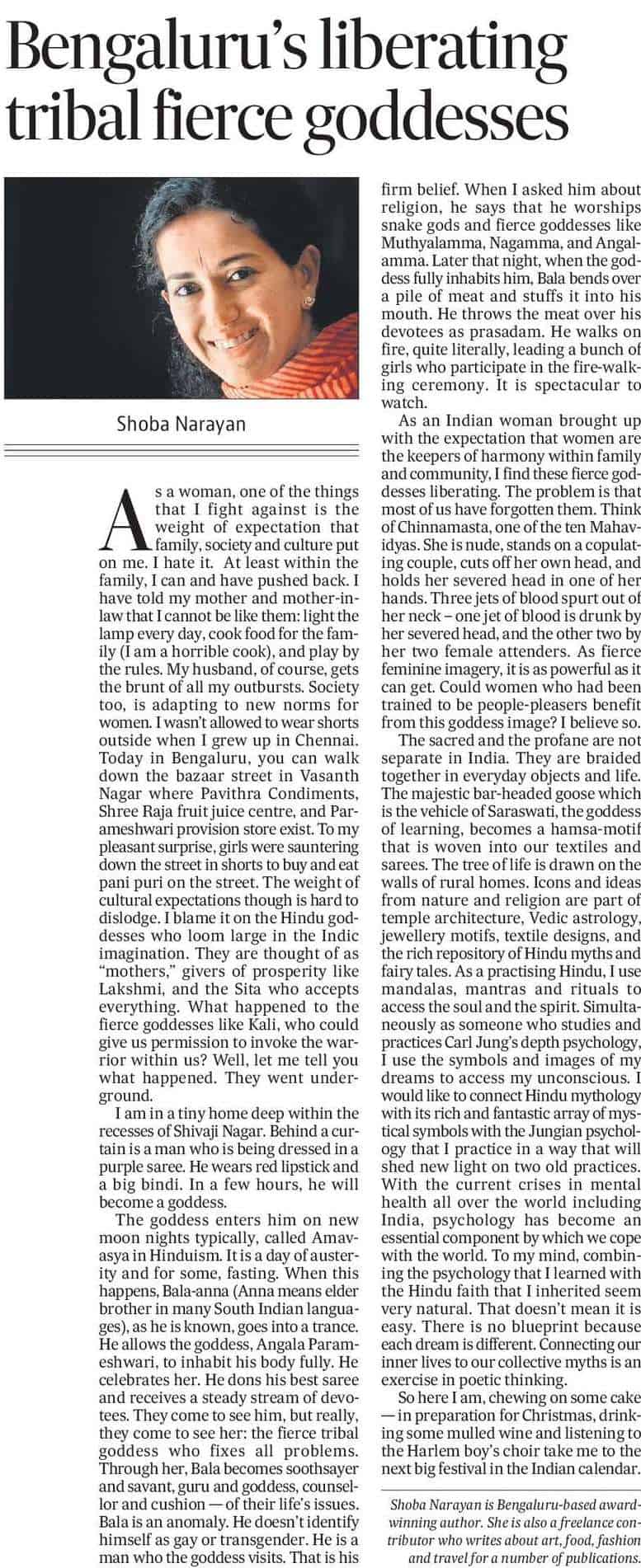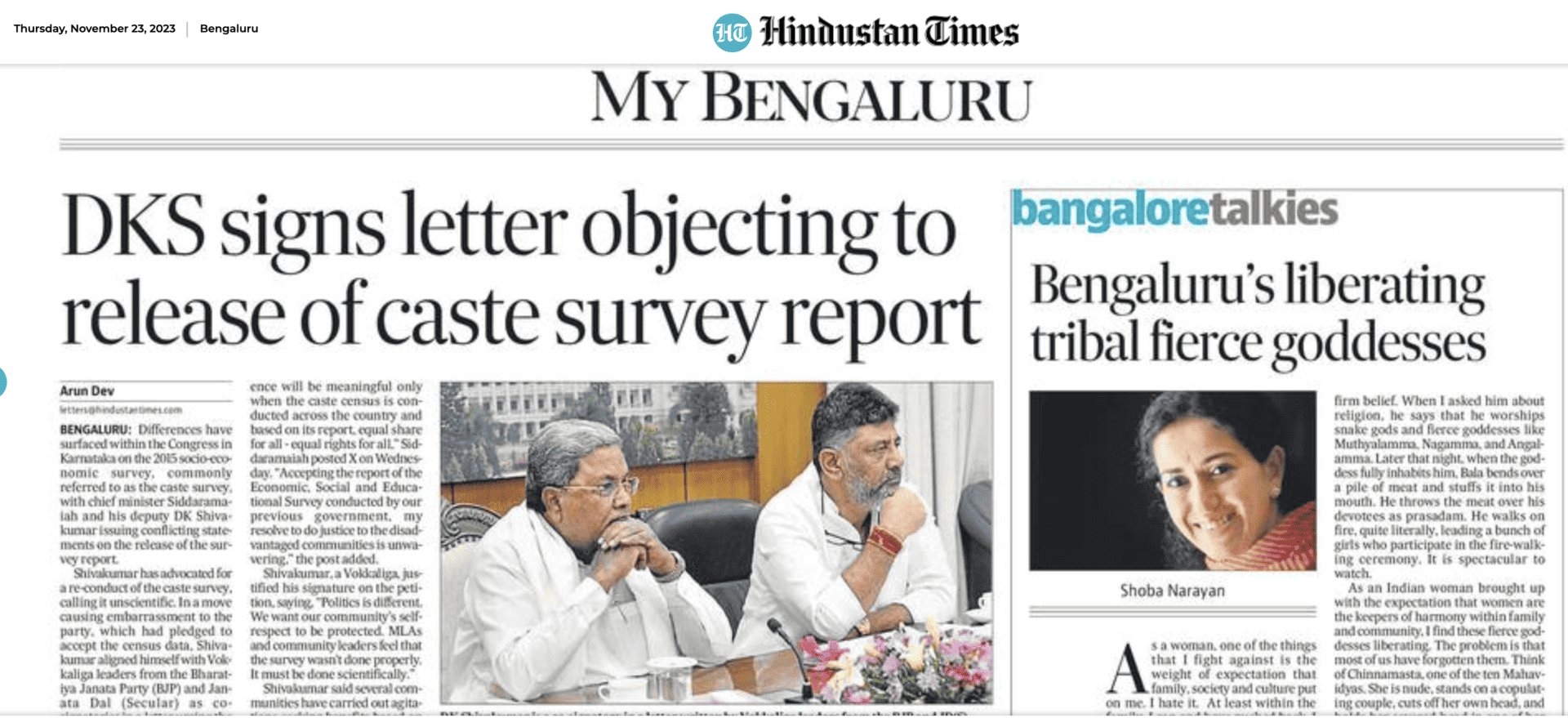As a woman, one of the things that I fight against is the weight of expectation that family, society and culture puts on me. I hate it. At least within the family, I can and have pushed back. I have told my mother and mother-in-law that I cannot be like them: light the lamp every day, cook food for the family (I am a horrible cook), and play by the rules. My husband, of course, gets the brunt of all my outbursts. Society too, is adapting to new norms for women. I wasn’t allowed to wear shorts outside when I grew up in Chennai. Today in Bangalore, you can walk down the bazaar street in Vasanth Nagar where Pavithra Condiments, Shree Raja fruit juice centre, and Parameshwari provision store exist. To my pleasant surprise, girls were sauntering down the street in shorts to buy and eat pani puri on the street. The weight of cultural expectations though are hard to dislodge. I blame it on the Hindu goddesses who loom large in the Indic imagination. They are thought of as “mothers,” givers of prosperity like Lakshmi, and the Sita who accepts everything. What happened to the fierce goddesses like Kali, who could give us permission to invoke the warrior within us? Well, let me tell you what happened. They went underground.
I am in a tiny home deep within the recesses of Shivaji Nagar. Behind a curtain is a man who is being dressed in a purple saree. He wears red lipstick and a big bindi. In a few hours, he will become a goddess.
The goddess enters him on new moon nights typically, called Amavasya in Hinduism. It is a day of austerity and for some, fasting. When this happens, Bala-anna (Anna means elder brother in many South Indian languages), as he is known, goes into a trance. He allows the goddess, Angala Parameshwari, to inhabit his body fully. He celebrates her. He dons his best saree and receives a steady stream of devotees. They come to see him, but really, they come to see her: the fierce tribal goddess who fixes all problems. Through her, Bala becomes soothsayer and savant, guru and goddess, counsellor and cushion– of their life’s issues. Bala is an anomaly. He doesn’t identify himself as gay or transgender. He is a man who the goddess visits. That is his firm belief. When I asked him about religion, he says that he worships snake gods and fierce goddesses like Muthyalamma, Nagamma, and Angalamma. Later that night, when the goddess fully inhabits him, Bala bends over a pile of meat and stuffs it into his mouth. He throws the meat over his devotees as prasadam. He walks on fire, quite literally, leading a bunch of girls who participate in the fire-walking ceremony. It is spectacular to watch.
As an Indian woman brought up with the expectation that women are the keepers of harmony within family and community, I find these fierce goddesses liberating. The problem is that most of us have forgotten them. Think of Chinnamasta, one of the ten Mahavidyas. She is nude, stands on a copulating couple, cuts off her own head, and holds her severed head in one of her hands. Three jets of blood spurt out of her neck– one jet of blood is drunk by her severed head, and the other two by her two female attenders. As fierce feminine imagery, it is as powerful as it can get. Could women who had been trained to be people-pleasers benefit from this goddess image? I believe so.
The sacred and the profane are not separate in India. They are braided together in everyday objects and life. The majestic bar-headed goose which is the vehicle of Saraswati, the goddess of learning, becomes a hamsa-motif that is woven into our textiles and sarees. The tree of life is drawn on the walls of rural homes. Icons and ideas from nature and religion are part of temple architecture, Vedic astrology, jewellery motifs, textile designs, and the rich repository of Hindu myths and fairy tales. As a practicing Hindu, I use mandalas, mantras and rituals to access the soul and the spirit. Simultaneously as someone who studies and practices Carl Jung’s depth psychology, I use the symbols and images of my dreams to access my unconscious. I would like to connect Hindu mythology with its rich and fantastic array of mystical symbols with the Jungian psychology that I practice in a way that will shed new light on two old practices. With the current crises in mental health all over the world including India, psychology has become an essential component by which we cope with the world. To my mind, combining the psychology that I learned with the Hindu faith that I inherited seem very natural. That doesn’t mean it is easy. There is no blueprint because each dream is different. Connecting our inner lives to our collective myths is an exercise in poetic thinking.
So here I am, chewing on some cake—in preparation for Christmas, drinking some mulled wine and listening to the Harlem boy’s choir take me to the next big festival in the Indian calendar.
Shoba Narayan is Bangalore-based award-winning author. She is also a freelance contributor who writes about art, food, fashion and travel for a number of publications.



-k4lD-U204025897261YmH-250x250%40HT-Web.jpg)




Leave A Comment